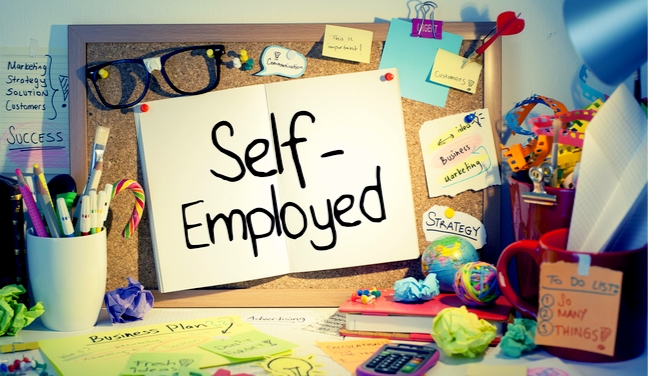The Freedom and Fall of Self-Employment
The “American Dream” that our parents and grandparents paint a picture of looks a little like this:
- Get a college degree
- Get a decent paying ‘job’ (a.k.a a place of employment punching a clock 9am-5pm Monday through Friday)
- Move up the ranks at said ‘job’, picking up a bigger paycheck, better benefits and a ton more responsibility
- Retire at 65 and live happily ever after

Our “Dance Dream” looks a little more like this:
- Get a college degree (that you may or may not be able to ever pay back on a dancer’s wages)
- Move to NY, LA or another big city where the cost of living is high
- Work a bunch of side hustles that are flexible enough to spend time at auditions, but that we’d never want to move up the ranks
- Attend said auditions and spend endless time and dollar potential to MAYBE:
LAND THAT GIG (INSERT DREAM HERE) THAT YOU’VE ALWAYS WANTED AND HOPEFULLY HAVE ENOUGH ON YOUR RESUME THAT YOU WORK FROM GIG TO GIG AND NEVER HAVE TO SIDE HUSTLE AGAIN
For us, number’s one through four are all worth it if it is the means to your dream and I 100% agree! What I love about us dancers is that we have some kind of gene that let’s us push our limits in all directions and gives no excuses as to what we accomplish that we set our mind to. I’ve never met anyone in the industry that doesn’t fit this description of a goal-getter. We couldn’t be successful any other way.
[pullquote]
“The main reason why people struggle financially is because they have spent years in school but learned nothing about money. The result is that people learn to work for money…but never let money work for them.”
– Robert Kiyosoki
[/pullquote]
So, with dancers having untraditional dreams, comes untraditional employment. While schools keep us laser focused on our dance dreams through teaching us about our technique, audition skills, resume writing, etc., what’s missing is the knowledge dancers need to survive self-employment.
What’s more, we can show dancers how to survive self-
employment, but even more THRIVE through business owner and investor mindset.
There’s a book by Robert Kiyosoki, called Rich Dad’s Cash Flow Quadrant: Rich Dad’s Guide to Financial Freedom, where it talks about the four ways people get paid. Dancer’s usually live in the land of self- employment:


Employee: You trade your time for dollars. For “normal people” these are their nine-to-fives. The American Dream that our parents and grandparents describe usually fits into this category. For dancers, this is also usually the side hustle category, in the retail or hospitality industry. The problem is we don’t work enough and/or don’t want to move up the ranks to get the same employer sponsored benefits (ie. 401K, insurance, paid vacations, etc.) as the nine-to-fivers because our dream doesn’t live in this category.
Self Employed: Again, you trade your time for dollars. Almost every dancer falls in to this category. You can tell if you fall into this if you receive a 1099, not a W-2, from your gigs. Being self employed you have a bit more freedom of your time, you’re not a slave to the big boss’ time clock. When someone asks you to teach a class or do a performance, you can say yes or no. This means you can choose your income.
You can search for more gigs (classes or performance opportunities) and fill up as much of your 24 hours as you possibly can, making whatever you decide your hourly rate is. But time, a commodity that you can never get back, is limited to the 24 hours each person is gifted with every day.
Business Owner: Here you are trading people’s time for dollars. In the dance industry, these are the studio owners, the competition owners, the company directors, etc. These are all the people that have others working to reach the goals of the business owner. This is where real freedom of time and money begins. For example, when I teach my dance classes I am a self employed individual. I teach my class, I get paid. That’s it. My studio owner is leveraging my time to make money. She has plenty of teachers, front desk staff, payroll managers, etc., helping to run her business. So she can be sipping drinks on the beach and her studio is still making her money!

Investor: An investor trades dollars for more dollars. What’s awesome is that anyone can be an investor, whether they are an employee, self employed or a business owner! Having your money making money is really where freedom of both time and money comes into play. Dancers have the mindset that they are destined to live paycheck-to-paycheck. If they pushed themselves a little more to pay themselves first (ie. save and invest a little each month) their financial futures would look a little less bleak.
95% of the population falls to the side of employee/self-employed. That leaves the 5% that have any semblance of freedom when it comes to time and their money. If you had an unlimited amount of time and money what could you accomplish in this world? How could YOU affect your family? Your community? The world of dance?!
Create your own opportunities. It is the best way to secure your future, within the dance world and outside of it. Find your entrepreneurial spirit and fill a need that you see within our community. Ask yourself:
- What you can do for the dance world? What are your strengths?
- What is something you see that the dance world could benefit from?
- Define what success means to you and why.
These questions can open up a plethora of ideas for you to continue to do what you love to do and create something that will provide value to our community. This gives you opportunities to run a system of people as a business owner and/or create more income as an investor.
Financial independence and freedom of your time, to me, is the dream. Once you’ve decided where you want to plant your flag in the dance world, the next step is to talk to s omeone about your financial dreams and goals. As a self employed individual or even a business owner, you are an expert in your field of dance and/or business. You’ve spent your life immersed in the field of dance and probably have
omeone about your financial dreams and goals. As a self employed individual or even a business owner, you are an expert in your field of dance and/or business. You’ve spent your life immersed in the field of dance and probably have
been looming in the ‘starving artist’ mindset for a good portion of your adult life. If I have a question about dance, I go to my dance mentors. I wouldn’t expect my dance mentors to be good at cutting my hair! For that I go to the ‘hair expert,’ right? Likewise with money – do your own research1 and then get an experts opinion. It is then that you will be able to step out of the ‘starving artist’ mindset and into the mindset of a financially independent individual.
1 – Some places to start:
- Money Master the Game by Tony Robbins
- Rich Dad Poor Dad by Robert Kiyosoki
- Tax Free Retirement by Patrick Kelly



